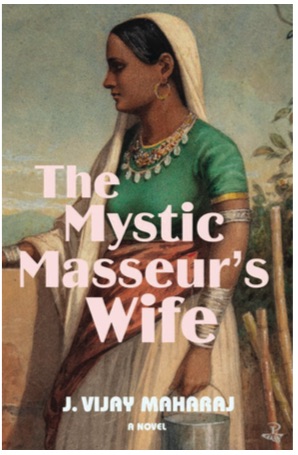Dr Vijay Maharaj’s new book ‘The Mystic Masseur’s Wife’, is a subversive reimagining of one Naipaul’s underserved characters

“Non-fiction can distort; facts can be realigned. But fiction never lies.” This quote from the late, Nobel Prize-winning author Sir Vidiadhar Surajprasad Naipaul seems ever more relevant with the publication of Dr J Vijay Maharaj’s debut novel, The Mystic Masseur’s Wife. Written in response to Naipaul’s classic The Mystic Masseur, Maharaj paints a poignant portrait of pre-Independence Trinidad, Indo-Trinidadian culture and womanhood.
Maharaj launched the novel during the 5th annual VS Naipaul Memorial virtually hosted by The UWI St Augustine’s Department of Literary, Cultural and Communication Studies (LCCS) on August 17, which would have been Naipaul’s 90th birthday. Featured speakers included former UWI St Augustine Campus Principal Dr Bhoendradatt Tewarie, Institute for Gender and Development Studies (IGDS) head Dr Sue-Ann Barratt, LCCS research assistant Ms Victoria Chang, IGDS lecturer Mr Tyrone Ali, IGDS research assistant Ms Renuka Anandjit, and Dr Maharaj.


The Mystic Masseur’s Wife begins where Naipaul’s Mystic Masseur ends. It shifts focus from his protagonist Ganesh Ramsumair, to his wife Leela. In Naipaul’s imagination, Leela played a peripheral role to Ganesh – a disgruntled writer who rises from poverty to politics through capitalising on his curious talent for healing the ill. At The Mystic Masseur’s end, Ganesh refashions himself as G Ramsay Muir, and leaves Leela behind to further his career in England.
Published in 1957, the novel is Naipaul’s first published work and it is his only work thus far to be made into a full-length feature film. It is as well-known and well-liked as the collection of popular short stories in Miguel Street and the classic epic, A House for Mr Biswas. The novel won the 1958 John Llewellyn Rhys Prize and was selected by the powerhouse team of Merchant-Ivory Productions for release as a film in 2001. Like many of the author’s works, it is regarded as a keen observation of Trinidadian society. The Mystic Masseur’s Wife compliments this book by giving Leela a voice, quite literally, as the novel is based on supposed tape recordings of her speaking with the near invisible narrator about her life with and without Ganesh.
Naipaul’s characterisation of Leela is on par with his positioning of women in most of his writing. According to Anandjit, Naipaul was “limited in his ability to frame women as individuals”, frequently falling on flawed characterisation and stereotypes. Naipaul’s Leela may have had some attributes of a modern woman – she was educated, for instance – but she was ultimately developed through the male gaze.
Similar sentiments were echoed by other panellists. Tewarie noted that Naipaul had come under heavy criticism for his portrayal of women, stating that they were “rarely central” in his work and given less sympathy or respect. Chang said that she had always been dissatisfied with his female characters. Maharaj’s Leela is a “subversive reimagining” as Anandjit described it.
Of particular interest to the panellists was Leela’s sexual agency in The Mystic Masseur’s Wife, since Naipaul’s portrayal of sex was frequently violent and dissatisfying for the participants. Through Leela’s new found voice, readers find out more about her relationship with her husband and also her lovers. The reconstruction of agency is what Barratt referred to as the “power of the disruption of a single story”.
Chang noted that The Mystic Masseur’s Wife is as much Leela’s history as it is the history of Trinidad and Tobago:
“This is a compelling Leela. She comes alive in a new and invigorating way. Leela was previously an invisible woman in Caribbean literature. In Naipaul’s work, male characters were fully made, while female characters played only supporting roles, and this is a far from complete portrait of the role of women in our society. I always felt dissatisfied with his female characters, although there were hints in the novel of Leela having a shrewd business mind.”
She added that the representation of Leela’s sexual agency put The Mystic Masseur’s Wife in the tradition of novels about female sexual awakening such as Gustave Flaubert’s Madame Bovary and Kate Chopin’s The Awakening. However, in The Mystic Masseur’s Wife, Leela does not find paradise in a lover as with other novels in this tradition. Leela finds paradise within herself. This is a key factor in the shift from the stereotypical portrayal of Indo-Trinidadian women.
“Well-written stories are the antithesis to ignorant stereotypes,” said Chang. As Tewarie noted, the novelist gave Leela an identity, ownership of that identity and ownership of her life and story.
For Maharaj, the novel presents an intellectual space to discuss history and culture.
“We have no public space for debating or proposing our thoughts about society. This is about wanting discussion on the society in which we live,” she said.
Dr J Vijay Maharaj is a lecturer in LCCS specialising in Caribbean Studies, cultural identity, and cultural citizenship. Her essays have been published in journals such as Anthurium, Tout Moun, and the Journal of West Indian Literature.
VS Naipaul, regarded as one of the greatest literary masters of his time, was a Trinidad-born British writer who most notably won the Nobel Prize for Literature in 2001. He has also won the Jerusalem and Booker Prizes. He received a knighthood and was awarded T&T’s highest honor, The Trinity Cross. Naipaul passed away on August 11, 2018 at 85.